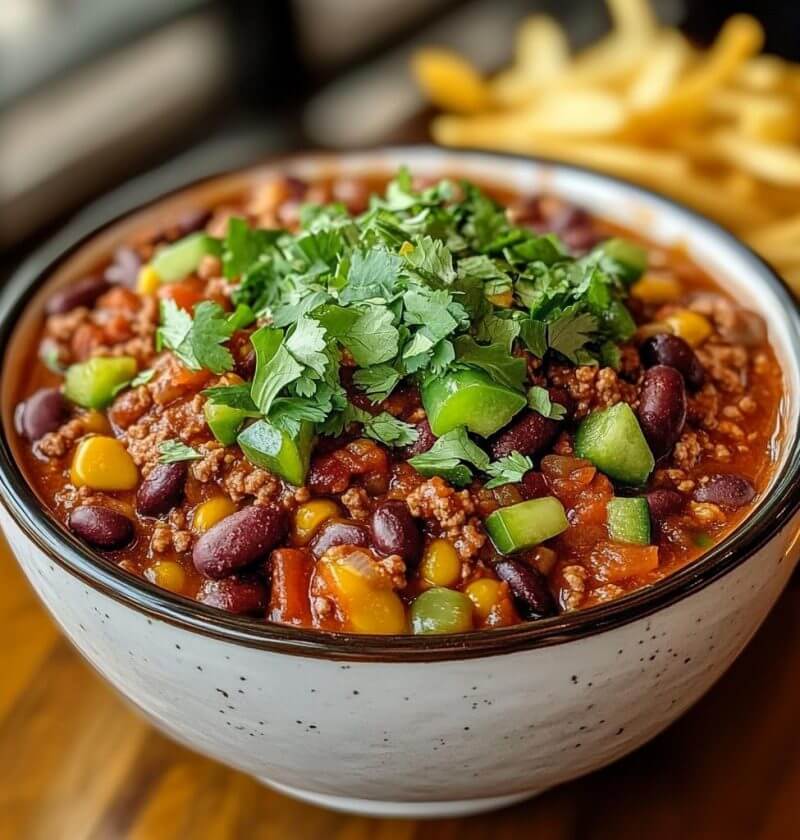Would you like to save this?
The chili debate is one of the most heated and passionate discussions in the world of food. Whether you’re a chili purist or someone who likes to push the boundaries of tradition, everyone has their own vision of what makes the perfect bowl of chili. The most fiery point of contention? The question of beans—do they belong, or should they be banished? Some chili aficionados insist that authentic chili is bean-free, while others argue that beans are a must-have ingredient. Today, we’ll delve into this spicy debate and, dare I say, make a case for why beans truly deserve their place in chili.
Before you decide whether you’re pro-bean or anti-bean, let’s dive into why this article is worth your time. If you’re a foodie, a home cook, or just someone who loves a warm, hearty bowl of chili, this read will open up new perspectives. Maybe it will challenge your beliefs about what constitutes authentic chili, or perhaps it will reinforce what you’ve always thought. Either way, it promises to be a tasty journey through the history, nutrition, and delicious possibilities of bean-inclusive chili.
A Rich History: The Evolution of Chili
To understand the beans versus no beans debate, it helps to know a bit about the history of chili. Known as chili con carne, this iconic dish is deeply rooted in Texan and Mexican cuisines. Traditionally, chili was a simple, hearty stew made from meat and chili peppers, often slow-cooked to create a rich, spicy flavor. This early version of chili was straightforward, meant to warm the body and satisfy the appetite.
But as chili traveled and gained popularity across different regions, its recipe evolved. Cooks began experimenting with new ingredients that could add complexity and depth to the dish. And one of the most common additions? Beans. Many see the addition of beans as a natural progression—they add new dimensions to the dish, transforming it into a more balanced and satisfying meal.
Why Beans Deserve a Spot in Your Chili Pot
So, why should you consider adding beans to your chili? Here are a few key reasons that might convince even the most dedicated purist.
1. Nutritional Powerhouses
Adding beans to your chili isn’t just about changing the flavor; it’s also about boosting the nutritional value of your meal. Here’s why beans are a smart choice:
- Rich in Protein: Beans are an excellent source of plant-based protein, which makes them a great complement to meat in chili. The combination of beans and beef, for example, creates a protein-packed dish that leaves you feeling full and satisfied.
- Packed with Vitamins and Minerals: Beans are full of essential nutrients like iron, magnesium, and B vitamins. These contribute to overall health and help maintain energy levels, making your chili not only delicious but also nourishing.
- High in Fiber: One of the most significant benefits of adding beans is their high fiber content. Fiber aids in digestion and promotes a healthy gut, which is especially welcome in a hearty dish like chili. It helps balance out the richness of the meat and the heat of the spices.
2. Enhancing Flavor and Texture
When it comes to the taste and feel of chili, beans bring a lot to the table. Many argue that the addition of beans can enhance both the flavor and texture of the dish in ways that even a traditional meat-only chili can’t match:
- Flavor Absorption: Beans have the unique ability to soak up the flavors of whatever they are cooked with, including the smoky spices, rich tomatoes, and savory meat found in chili. This allows them to meld seamlessly into the dish, creating a harmonious blend of tastes.
- Creamy Texture: Beans add a creamy, velvety texture that balances the bold flavors of chili. They create a contrast with the meaty chunks, making every spoonful a more satisfying experience.
- Variety of Choices: There are so many types of beans to choose from, each bringing its own unique qualities. Whether you prefer the heartiness of kidney beans, the mild creaminess of pinto beans, or the earthy taste of black beans, you can customize your chili to match your flavor preferences.
3. Customization and Flexibility
One of the best things about chili is its versatility. It’s a dish that invites experimentation and allows you to make it your own. Adding beans opens up even more possibilities for creativity:
- Mix and Match Beans: Don’t settle for just one type of bean! Combine black beans, pinto beans, and kidney beans to create a more complex flavor profile. Each bean offers a slightly different taste and texture, making your chili unique.
- Budget-Friendly: Beans can help you stretch your chili recipe further, making it a great option when cooking for a crowd. They are an affordable ingredient that allows you to make a larger pot of chili without sacrificing quality or taste.
- Meatless Options: If you’re cooking for vegetarians or simply trying to cut back on meat, beans can easily become the star of the show. A bean-based chili can be just as rich and flavorful as one made with beef or pork, making it a fantastic option for a variety of diets.
The Purists’ Perspective: Why Some Say No to Beans
Of course, in the interest of fairness, it’s important to consider the perspective of chili purists who believe beans have no place in chili. Traditionalists argue that authentic chili should stick to its roots: a simple stew of meat and chili peppers, free of extras like beans or even tomatoes. To them, adding beans is a betrayal of the dish’s origins and dilutes the intense, meaty essence that defines chili con carne.
For many, this debate is about honoring history and preserving a classic recipe in its purest form. It’s not so much about the taste as it is about staying true to tradition. But, like many culinary arguments, this comes down to personal preference, and there’s room for everyone’s taste buds at the table.
In Conclusion: Why Beans Belong in Chili
While the debate over beans in chili may never be fully resolved, it’s clear that including beans offers numerous advantages. From enhancing the nutritional value and adding rich flavors and textures to allowing for more customization, beans bring a lot to the pot. Whether you’re looking to create a chili that’s rich and creamy, stretch a recipe to serve more guests, or simply try something new, beans can be the secret ingredient that takes your chili to the next level.
So, if you’ve been skeptical about adding beans to your chili, why not give it a try? Experiment with different types, play with the proportions, and find the combination that makes your taste buds sing. You might just discover that beans in chili are the winning combination you’ve been searching for all along.
In the end, chili is about comfort, warmth, and bringing people together—whether your version includes beans or not. But if you ask me, a bowl of chili with beans is like a cozy sweater on a cold day: comforting, hearty, and just right. Happy cooking, and may your next pot of chili be as perfect as you imagined!







